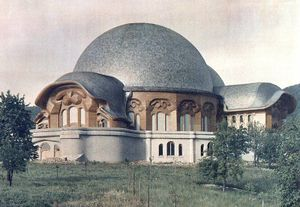Architecture

Architecture (from Greek: αρχη arché "beginning, origin, foundation, the first" and τεχνη techné "art, craft, handicraft" or τεκτόν téktón "carpenter, master builder") is, taken literally, the "first craft" or the "first art" in general. It is based on the feeling of space, which arises from the inner experience of the physical body. If one observes how the human being walks and stands, one arrives at the architectural forms. This usually leads to the development of a regional or supra-regional architectural style that is typical for the respective epoch and today increasingly also for a specific architect.
„As far as you study the human being in movement and standing, you get the form of architecture. A perfect building is nothing other than the perfect standing and walking of man. Every culture has conceived and represented this static and dynamic in man through its architecture in a different way. The Assyrian-Babylonian culture represented the proclamation of the Logos more through the leaning forward of man, the Greek culture through the quiet standing. One need only know the way in which man stands in the world in order to recognise all forms of construction in a lively way. Today, the building imagination is very limited. And yet the architectural style of today must be one that is born out of human self-awareness, that flows from "know thyself". This has been attempted at the Goetheanum.“ (Lit.:GA 217a, p. 112f)
„We become acquainted, so to speak, with the outermost part of our being, that which proceeds through the action of our etheric body on our physical body, in a spatial system of lines and forces. If we carry this spatial system of lines and forces, which is basically continually active in us, out into the world and arrange matter according to this system of forces, if we detach this system of forces from us and arrange matter according to it, then the art of building comes into being. And all architecture consists in detaching this system of forces from us and putting it out into space. So that we can say: If we mean here schematically the outermost limits of our physical body, then we push the inner lawfulness, which is impressed upon the physical body by the etheric body, outside of us, and thereby the art of building comes into being. - Everything that is present in the laws of building in the assemblage of matter is also to be found in the human body. The art of building, architecture, is the projection of the laws of the human body outside of us into space.
Now we know that for our observation the physical body is followed by the etheric body. If we turn our gaze back once more to any work of architecture, what can we say about this work of architecture? We can say that there, carried out into the space outside, is the relationship between vertical and horizontal forces and between forces that act on each other, as they otherwise do in the human physical body. That is carried out.“ (Lit.:GA 275, p. 43)
Literature
- Khaled Saleh Pascha: Gefrorene Musik. Das Verhältnis von Architektur und Musik in der ästhetischen Theorie, Dissertation at the Technical University of Berlin 2004 academia.edu
- Rudolf Steiner: Das Hereinwirken geistiger Wesenheiten in den Menschen, GA 102 (2001), ISBN 3-7274-1020-5 English: rsarchive.org German: pdf pdf(2) html mobi epub archive.org
- Rudolf Steiner: Welt, Erde und Mensch, GA 105 (1983), Erster Vortrag, Stuttgart, 4. August 1908 English: rsarchive.org German: pdf pdf(2) html mobi epub archive.org
- Rudolf Steiner: Die Erkenntnis-Aufgabe der Jugend, GA 217a (1981), ISBN 3-7274-2175-4 English: rsarchive.org German: pdf pdf(2) html mobi epub archive.org
- Rudolf Steiner: Kunst im Lichte der Mysterienweisheit, GA 275 (1990), ISBN 3-7274-2750-7 English: rsarchive.org German: pdf pdf(2) html mobi epub archive.org
 |
References to the work of Rudolf Steiner follow Rudolf Steiner's Collected Works (CW or GA), Rudolf Steiner Verlag, Dornach/Switzerland, unless otherwise stated.
Email: verlag@steinerverlag.com URL: www.steinerverlag.com. Index to the Complete Works of Rudolf Steiner - Aelzina Books A complete list by Volume Number and a full list of known English translations you may also find at Rudolf Steiner's Collected Works Rudolf Steiner Archive - The largest online collection of Rudolf Steiner's books, lectures and articles in English. Rudolf Steiner Audio - Recorded and Read by Dale Brunsvold steinerbooks.org - Anthroposophic Press Inc. (USA) Rudolf Steiner Handbook - Christian Karl's proven standard work for orientation in Rudolf Steiner's Collected Works for free download as PDF. |
